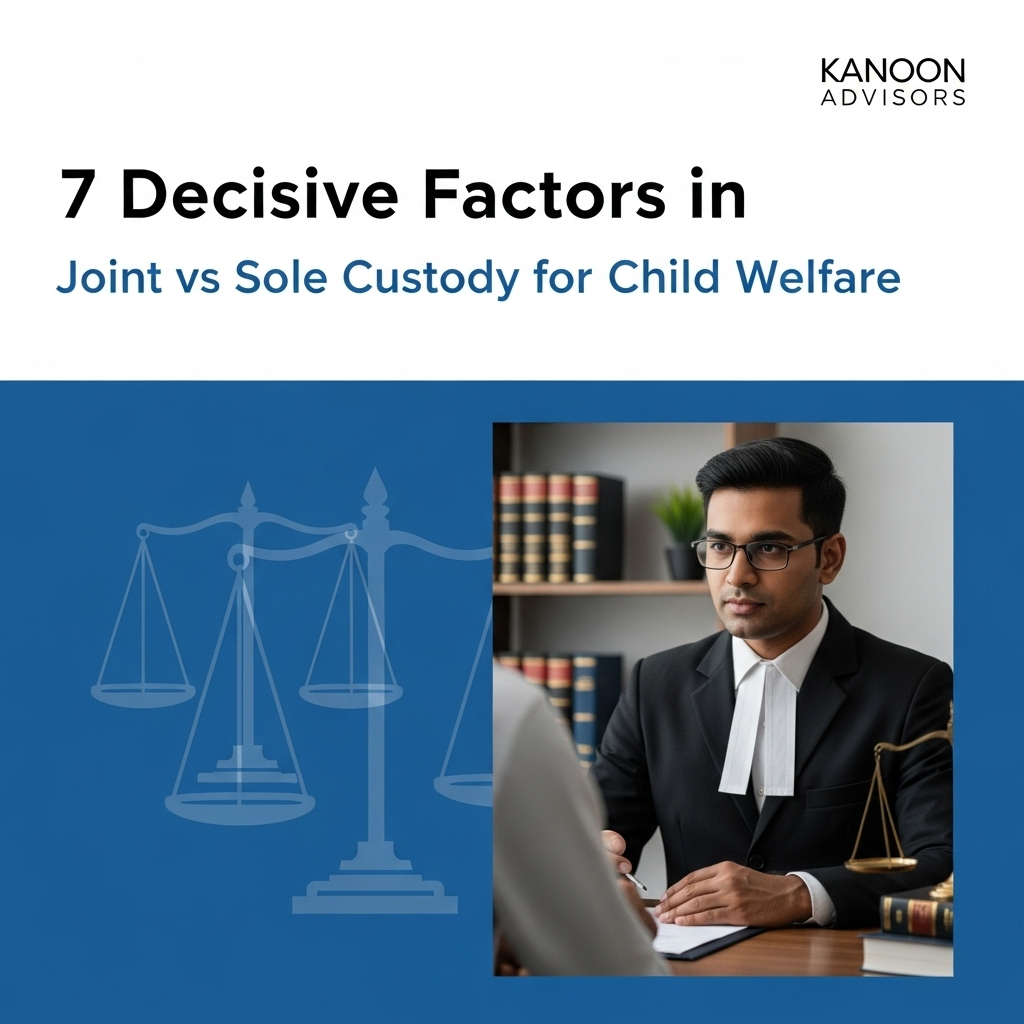
7 Decisive Factors in Joint vs Sole Custody for Child Welfare
Navigating a child custody dispute is one of the most emotionally challenging experiences a parent can face. In the midst of personal turmoil, the primary concern of the Indian legal system, particularly the family courts in Delhi NCR, remains steadfast: securing the “welfare of the child.” This principle governs every decision, making it crucial for parents to understand the legal nuances of joint vs sole custody. At The Kanoon Advisors, with over 40 years of combined legal practice, we have guided hundreds of families through these sensitive matters, ensuring the child’s best interests are always at the forefront.
This comprehensive guide is designed to demystify the custody process in India for 2025. We will break down the legal definitions, explore the critical factors courts consider, and provide a clear, step-by-step overview of the legal procedure. Our goal is to empower you with the knowledge needed to make informed decisions during a difficult time, backed by the extensive experience of our legal team serving clients across Delhi NCR including Gurgaon, Delhi, Faridabad, and Noida.
Quick Answer
Joint vs sole custody decisions in India hinge entirely on the child’s welfare. According to legal data, courts now increasingly favor co-parenting arrangements where feasible, with joint custody petitions seeing a rise of nearly 30% in metropolitan family courts. The court’s primary considerations are: 1. The child’s age and emotional needs, 2. Each parent’s capacity to provide a stable environment, and 3. The child’s preference, if they are old enough to express it.
Table of Contents
- Understanding Custody Types: Joint vs. Sole
- The Paramount Consideration: The “Best Interests of the Child”
- 7 Decisive Factors Influencing Custody Decisions in Delhi NCR Courts
- Comparing Joint vs. Sole Custody: A Practical Breakdown
- The Legal Process for a Custody Order in Delhi NCR
- About The Kanoon Advisors
- Frequently Asked Questions
- Conclusion: Navigating Custody with Clarity
Understanding Custody Types: Joint vs. Sole
Before delving into the factors that influence a court’s decision, it is essential to understand the fundamental differences between the types of custody arrangements available under Indian law. The terms are often misunderstood, but their legal implications are significant for both the parents and the child.
What is Sole Custody?
Sole custody grants one parent the exclusive right and responsibility to make all major decisions concerning the child’s life. This includes decisions about education, healthcare, religious upbringing, and overall welfare. The child primarily resides with the custodial parent, while the non-custodial parent is typically granted visitation rights. Courts may award sole custody in situations where one parent is deemed unfit due to abuse, neglect, substance addiction, or an unstable lifestyle, thereby ensuring the child’s safety and stability.
What is Joint Custody?
Joint custody is a more modern approach where both parents share the decision-making responsibilities for the child. This arrangement can be further divided:
- Joint Physical Custody: The child spends significant periods residing with both parents. This does not necessarily mean a 50/50 split but involves a structured schedule that allows both parents to be actively involved in the child’s daily life.
- Joint Legal Custody: Both parents have an equal say in major life decisions, even if the child primarily lives with one parent (who has physical custody). This is the more common form of joint custody awarded by Indian courts.
This arrangement is preferred when both parents are capable and willing to cooperate for the child’s benefit, as it fosters a healthy relationship with both parents.
The Legal Framework in India: The “Welfare of the Child” Principle
Child custody in India is primarily governed by the Guardians and Wards Act, 1890, a secular legislation applicable to all citizens. For Hindus, the Hindu Minority and Guardianship Act, 1956, also applies. Regardless of the statute, the single, unyielding principle that the Supreme Court of India has repeatedly upheld is the “welfare of the child.” This means the court’s decision is not about the rights of the parents, but about what arrangement best serves the child’s moral, physical, emotional, and educational development.
The Paramount Consideration: The “Best Interests of the Child”
Every custody battle adjudicated in a Delhi NCR family court begins and ends with one central question: What is in the best interest of the child? This is not merely a guideline but the definitive legal standard. The court takes on the role of parens patriae (parent of the nation) to protect the child’s welfare above all else. This involves a holistic assessment of the child’s circumstances and future well-being.
How do courts determine these “best interests”?
The court undertakes a comprehensive evaluation of various factors. It is not a mathematical formula but a careful, considered judgment based on the evidence presented and, often, interactions with the child and parents. Landmark judgments from the Supreme Court, such as in the case of Gaurav Nagpal v. Sumedha Nagpal, have established that the child’s welfare is the “paramount consideration” and cannot be determined by a single factor. The court will weigh a combination of elements to create a complete picture of what environment will best allow the child to thrive.
7 Decisive Factors Influencing Custody Decisions in Delhi NCR Courts
Drawing from our extensive experience in family law at The Kanoon Advisors, we have identified seven key factors that consistently play a pivotal role in the decisions made by family courts in Delhi, Gurgaon, and the surrounding regions. Understanding these can help you prepare your case more effectively.
1. Age and Gender of the Child
The “tender years doctrine” often applies, suggesting that very young children (typically under seven) are best placed with their mother. However, this is not an absolute rule and can be rebutted if the father can prove he is the better caregiver. For older children, their gender and comfort level with each parent may also be considered.
2. Financial Stability of the Parents
While the court does not simply award custody to the wealthier parent, the ability to provide for the child’s basic needs, education, and lifestyle is crucial. The court assesses each parent’s financial capacity to ensure a stable and secure environment. It is about adequacy, not luxury.
3. Physical and Mental Health of the Parents
A parent’s physical and mental health is evaluated to determine their capacity to handle the demands of childcare. A chronic illness or mental health condition does not automatically disqualify a parent, but the court will consider its potential impact on the child’s well-being and the parent’s ability to provide consistent care.
4. The Child’s Preference (If of a Discerning Age)
According to Indian law, if a child is old enough to form an intelligent preference (usually above 9 years old), the court must consider their wishes. This is typically done in a private interview with the judge, away from the parents, to ensure the child can speak freely without coercion. While the child’s preference is a significant factor, it is not the only one; the court will weigh it against other welfare considerations.
5. Parent’s Lifestyle and Moral Character
The court examines each parent’s lifestyle only to the extent that it affects the child. Issues like alcoholism, criminal activity, or neglectful behaviour can heavily influence the decision against a parent. The focus is always on whether the parent’s conduct creates a safe and nurturing environment for the child.
6. History of Domestic Violence or Abuse
Any credible allegation or proof of domestic violence, child abuse, or neglect is a critical and often decisive factor. The court’s primary duty is to protect the child from harm. A parent with a history of abuse is highly unlikely to be granted custody, and even visitation rights may be restricted or supervised. According to court statistics, verified claims of abuse are a leading reason for awarding sole custody.
7. Willingness to Foster a Relationship with the Other Parent
Courts in 2025 are increasingly looking for the parent who is more likely to support and encourage the child’s relationship with the other parent. Any attempt to alienate the child from the other parent (parental alienation) is viewed very negatively and can severely damage that parent’s claim for custody. A willingness to co-parent effectively is a strong indicator of putting the child’s needs first.
Comparing Joint vs. Sole Custody: A Practical Breakdown
To help clarify the day-to-day implications of each arrangement, here is a comparative table highlighting the key differences between sole and joint custody.
| Feature | Sole Custody | Joint Custody |
|---|---|---|
| Decision-Making Power | Held exclusively by one parent (the custodial parent). | Shared by both parents, requiring mutual agreement on major issues. |
| Living Arrangements | Child lives primarily with one parent. The other parent has visitation rights. | Can involve the child living with both parents on a rotational basis (physical custody) or primarily with one while decisions are shared (legal custody). |
| Co-Parenting Requirement | Minimal co-parenting required, mainly for coordinating visitation. | High level of communication and cooperation is essential for success. |
| Stability vs. Flexibility | Provides a single, stable home environment, which can be beneficial for the child. | Offers flexibility but can be disruptive if not managed well. Requires a detailed parenting plan. |
| When It’s Awarded | Often in cases of parental unfitness, abuse, high conflict, or when parents live far apart. | Awarded when both parents are deemed fit, cooperative, and live in reasonable proximity to each other. |
The Legal Process for a Custody Order in Delhi NCR
Navigating the family court system can be intimidating. Having an experienced child custody lawyer is vital. Here is a simplified step-by-step overview of the procedure in Delhi NCR.
Step-by-Step Procedure in Family Court
- Step 1: Filing the Custody Petition. The process begins when one parent files a petition for custody in the family court that has jurisdiction (usually where the child resides). The petition details the reasons for seeking custody and outlines the proposed arrangement.
- Step 2: Service of Notice to the Other Parent. The court issues a notice to the other parent (the respondent), who is then required to appear in court on a specified date.
- Step 3: Mediation and Counselling. Family courts in Delhi NCR strongly encourage mediation. A neutral, court-appointed mediator helps parents try to reach an amicable agreement. If an agreement (a “parenting plan”) is reached, it can be made an order of the court.
- Step 4: Filing of Written Statements and Evidence. If mediation fails, both parties file their replies, rejoinders, and evidence. This includes documents like income statements, school records, and any proof supporting their claims about the other parent’s fitness.
- Step 5: Trial and Final Arguments. The trial phase involves the examination and cross-examination of witnesses. The judge may also interact with the child at this stage. Finally, the lawyers for both sides present their final arguments, summarizing the evidence and citing legal precedents.
- Step 6: The Final Custody Order. After considering all the evidence, arguments, and keeping the child’s welfare as the paramount consideration, the judge passes a final, binding custody order. This order will detail the type of custody, visitation schedules, and other relevant conditions.
About The Kanoon Advisors
With over 40 years of combined legal experience and 500+ successful cases, The Kanoon Advisors is a trusted law firm serving clients across Delhi NCR. Founded by Shri Gokal Chand Yadav and led by Partner Vishal Yadav, our expertise spans criminal law, family disputes, property matters, and financial legal issues with a 95% client satisfaction rate. Our team’s deep understanding of family court procedures ensures that our clients receive expert guidance focused on protecting their child’s future.
Related Legal Services
Frequently Asked Questions
Q1: Can a father get sole custody in India?
Yes, a father can absolutely get sole custody in India. The court’s decision is not based on gender but on who can better provide for the child’s welfare. If a father can demonstrate that the mother is unfit or that he is the more suitable parent to ensure the child’s well-being, he has an equal chance of being awarded sole custody.
Q2: Is joint custody becoming more common in India?
Yes, there is a clear trend towards joint custody, especially in metropolitan areas like Delhi NCR. Courts recognize the importance of having both parents involved in a child’s upbringing. According to legal data, family courts are increasingly recommending joint custody arrangements, provided the parents can cooperate without hostility.
Q3: What happens if one parent wants to move to another city?
A parent with custody cannot unilaterally decide to relocate with the child, especially if it disrupts the other parent’s visitation rights. They must seek permission from the court. The court will evaluate the request based on the reason for the move and whether it serves the child’s best interests, not just the parent’s convenience.
Q4: How is child support calculated in custody cases?
Child support, or maintenance, is calculated based on the needs of the child and the financial capacity of the parents. The court considers the income, assets, and liabilities of both parents to determine a reasonable amount that ensures the child maintains their standard of living. The non-custodial parent is typically ordered to pay maintenance to the custodial parent.
Q5: Can a custody order be changed later?
Yes, a custody order is not set in stone. It can be modified if there is a significant change in circumstances. For example, if the custodial parent’s living situation becomes unstable or the child’s needs change, the other parent can file a petition to modify the existing order. The court will again decide based on the child’s welfare.
Q6: Do I absolutely need a lawyer for a child custody case?
While it is technically possible to represent yourself, it is highly inadvisable. Child custody laws are complex, and the procedure involves intricate legal arguments and evidence presentation. An experienced family lawyer can navigate the system, protect your rights, and present your case in the most effective way to ensure the best possible outcome for your child.
Legal Disclaimer
This information is provided for educational purposes only and does not constitute legal advice. Every legal situation is unique, and outcomes depend on specific facts and circumstances. Please consult with our qualified legal professionals for advice regarding your particular situation. Past results do not guarantee future outcomes.
Conclusion: Navigating Custody with Clarity
The determination between joint vs sole custody is one of the most critical decisions a family court can make. As we’ve explored, the singular focus of the Indian judiciary is the welfare and best interests of the child. The outcome is not decided by parental rights but by a meticulous evaluation of factors ranging from parental capacity to the child’s own preference. Understanding these custody decision factors is the first step toward advocating effectively for your child’s future.
These matters are profoundly personal and legally complex. The guidance of a seasoned legal professional is invaluable. At The Kanoon Advisors, our team is dedicated to providing compassionate, strategic, and effective representation to protect what matters most—your child.
If you are facing a child custody dispute in Delhi NCR, don’t navigate it alone. Our experienced team offers a range of legal services tailored to family law. Contact our experienced legal team today to schedule a consultation and ensure your child’s best interests are vigorously represented.


